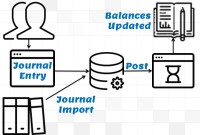- Home
- Business Processes
- Industry Knowledge
- Aerospace Industry
- Automotive Industry
- Banking Domain
- BFSI Industry
- Consumer/ FMCG Industry
- Chemicals Industry
- Engineering & Construction
- Energy Industry
- Education Domain
- Finance Domain
- Hospitality Domain
- Healthcare Industry
- Insurance Domain
- Retail Industry
- Travel and Tourism Domain
- Telecom Industry
- Leadership Skills
- eLearning
- Home
- Functional
- General Ledger (Record to Report)
- GAAP to STAT Adjustments
GAAP to STAT Adjustments
Understand what we mean by GAAP to STAT adjustments. This article discusses the different standards that are used for multiple representations of the financial results for global organizations. Understand the meaning of US GAAP, Local GAAP, STAT, IFRS, and STAT. Finally, understand why accounting differences arise and how they are adjusted for different financial representations.
Why do we have different Standards?
All companies keep track of their financial results through accounting using the general ledger. However, during the process, there are several different methods of accounting that these companies can use, and usage of these methods can result in different accounting treatments for the same transaction. Cash and Accrual are two fundamental accounting methods.
Leveraging the fundamental principles of accounting, different bodies prescribe some standards that need to be followed by organizations coming under their authority. The Financial Accounting Standards Board (FASB) is the authoritative body having the primary responsibility for developing accounting principles. The FASB publishes Statements of Financial Accounting Standards as well as Interpretations of these Standards.
Apart from “Financial Accounting Standards Board” (FASB), the American Institute of Certified Public Accountants (AICPA), and the Securities and Exchange Commission (SEC) along with the statutory authoritative bodies of various countries (Example – Institute of Chartered Accountants of India, for India), all have all played an influential role in developing generally accepted accounting principles which span across boundaries of nation and have global acceptability. Efforts are still going on to emerge globally accepted principles, as we still found variations in principles from countries to countries as well as from businesses to businesses that warrant a need to have different accounting methods.
Companies following under the jurisdiction of different geographies may have to follow standards prescribed by different bodies. For example, all companies that are registered in the United States of America need to follow US GAAP, and if, these counties are operating in different countries, they need to follow the accounting standards prescribed by the governments of that particular country for the legal entities registered in these foreign countries.
What are these Standards?
Two of the most common accounting methods that businesses employ are the Generally Accepted Accounting Principles and the STAT (Local Statutory Accounting Principles). To convert from one standard to another method, a business must make certain adjustments to its financial statements. Given below are some of the commonly used standards:
- US GAAP (the US Generally Accepted Accounting Principles)
- Local GAAP (Local Generally Accepted Accounting Principles)
- IFRS (International Financial Reporting Standards)
- Tax Standards & Other Industry Specific Standards
- STAT (Local Statutory Accounting Principles)
- SAP (Statutory Accounting Principles)
Method 1: What is USGAAP?
In the U.S., Generally Accepted Accounting Principles are accounting rules used to prepare, present, and report financial statements for a wide variety of entities, including publicly traded and privately held companies, non-profit organizations, and governments. The term is usually confined to the United States; hence it is commonly abbreviated as US GAAP.
US GAAP is not written in the law, although the U.S. Securities and Exchange Commission (SEC) requires that it be followed in financial reporting by all publicly traded companies. The Financial Accounting Standards Board (FASB) is the highest authority in establishing generally accepted accounting principles for public and private companies, as well as non-profit entities. All companies registered with US SEC have to comply and present their financial statements as per USGAAP.
Method 2: What is Local GAAP?
Generally Accepted Accounting Principles encompass the entire industry of accounting and not only the United States. As US Government has notified standards for US companies, similarly most of the countries have established and notified accounting standards and principles that need to be adhered to and complied with all organizations operating within the jurisdiction of respective countries. Generally Accepted Accounting Principles (GAAP) refer to the standard framework of guidelines for financial accounting used in any given jurisdiction; generally known as accounting standards. Local GAAP includes the standards, conventions, and rules accountants follow in recording and summarizing, and in the preparation of financial statements, where the word local refers to and can be replaced by the respective authority or jurisdiction. For example - A US company operating in other countries needs to comply with respective Local GAAPs for operations in respective countries and need to report its consolidated results in US GAAP.
Method 3: What is IFRS?
International Financial Reporting Standards (IFRS) are principles-based standards, interpretations, and the framework adopted by the International Accounting Standards Board (IASB). They are also known by the older name of International Accounting Standards (IAS) and they aim for international accounting standards that can be adopted by all organizations worldwide.
Among other standards, IFRS is best positioned to be a global standard. Local and US GAAPs are slowly being phased out in favor of the International Financial Reporting Standards as the global business becomes more pervasive. US GAAP applies only to United States financial reporting and thus an American company reporting under US GAAP might show different results if it was compared to a British company that uses the International Standards or Local UK GAAP. While there is a tremendous similarity between GAAP and the international rules, the differences can lead a financial statement user to incorrectly believe that company A made more money than company B simply because they report using different rules. The move towards International Standards seeks to eliminate this kind of disparity. At present, IFRS is used in many parts of the world, including the European Union, India, Hong Kong, Australia, Malaysia, Pakistan, GCC countries, Russia, South Africa, Singapore, and Turkey. As of August 2008, more than 113 countries around the world require or permit IFRS reporting. It is generally expected that IFRS adoption worldwide will be beneficial to investors and other users of financial statements, by reducing the costs of comparing alternative investments and increasing the quality of information. However, this requires a big-picture strategic approach that ensures global consistency in financial reporting policies and practices.
Method 4: What are Tax Standards & Other Industry Specific Standards?
Many governments prescribe different accounting standards for companies operating in a particular domain. For example, US SAP is a set of accounting standards and procedures that insurance companies use to report their financial data. US GAAP and US SAP procedures differ considerably. State insurance regulators require insurance companies to keep their accounting records for filing annual financial reports in accordance with statutory accounting principles (SAP) and the Statutory Accounting Principles (SAP) forms the basis for preparing the financial statements of insurance companies. As the US insurance industry falls under state regulation, actual rules vary further by state. Similarly, tax laws for various countries may prescribe different accounting treatments in certain cases that do not match even with the respective Local GAAPs.
Method 5: What is the STAT (Local Statutory Accounting Principles)?
Today organizations are more global than ever and they operate across boundaries of nations. GAAP and STAT in this context are terms used to define how the results of a multinational corporation will be recorded and reported for different purposes. In the context of general ledger, GAAP generally refers to the GAAP prescribed by the home country where the organization’s parent company is registered and has an obligation to report the consolidated results. The STAT term is generally used to refer to the local statutory books of accounts to reflect the operations in a specific foreign country for operations in that country as per the Local GAAP for that specific country.
What is GAAP to STAT adjustments?
As companies need to report results from the same business operations using different accounting standards, they need to make adjustments to their recorded financial data, to convert the financial information recorded using one accounting method to another. These adjustments entries are in the nature of permanent adjustments, timing adjustments, reclassifications, or eliminations.
- Under Local GAAP accounting, payments for goods or services may be recorded as expenses however for US GAAP (full accrual basis) accounting, payments made in this fiscal year for goods and services that won’t be used until after the end of the year represent purchases of assets, not expenses and GAAP adjustment is required for the portion of the goods or services that will be used in future years. This is an example of GAAP to STAT adjustment arising out of a timing difference.
- SAP applicable for insurance companies operates on different accounting principles to provide information that is useful under different industry-specific circumstances. For example, SAP guidelines are used to prepare financial statements that allow investors to determine the ability of the insurance company to pay their future claims. In other words, if all customers of the insurance company had a claim at present, SAP helps to determine if the company would be able to pay those insurance claims. On the other hand, US GAAP guidelines treat a business as a going concern, and therefore, the focus is on preparing the financial statements by matching revenues with expenses, so an investor can gauge the underlying profitability of the business for the current year.
- Various tax laws applicable in various countries prescribe different rules for the treatment of assets for accounting purposes. The depreciation rules are different and there are differences in the way the residual value can be considered. While most assets have at least some value under GAAP, some assets might not have any value under the TAX method.
How to make GAP to STAT adjustments:
To adjust a balance sheet from one accounting method to another (for example GAAP to STAT), an accountant must identify and adjust the accounting entries that would require a different treatment. From an accounting perspective, there are three distinct stages for this adjustment process, assess individual situation and requirements, complete the conversion activities, and sustain ongoing reporting. Organizations need to develop a framework and systems design for accounting, reporting, consolidation, and reconciliation processes and controls. Modern general ledger systems enable accountants to organize and record accounting data by providing an operating model for multiple financial representations.
Related Links
You May Also Like
-
In this article, we will describe how to determine if an account needs adjustment entries due to the application of the matching concept. Learners will get a thorough understanding of the adjustment process and the nature of the adjustment entries. We will discuss the four types of adjustments resulting from unearned revenue, prepaid expenses, accrued expenses, and accrued revenue.
-
Divisional Organizational Structures
The divisional structure or product structure consists of self-contained divisions. A division is a collection of functions which produce a product. It also utilizes a plan to compete and operate as a separate business or profit center. Divisional structure is based on external or internal parameters like product /customer segment/ geographical location etc.
-
Although technically a general ledger appears to be fairly simple compared to other processes, in large organizations, the general ledger has to provide many functionalities and it becomes considerably large and complex. Modern business organizations are complex, run multiple products and service lines, leveraging a large number of registered legal entities, and have varied reporting needs.
-
What is Accounting & Book Keeping
Accounting is a process designed to capture the economic impact of everyday transactions. Each day, many events and activities occur in an entity, these events and activities are in the normal course of business; however, each of these events may or may not have an economic impact. Events or activities that have an effect on the accounting equation are accounting events.
-
GL - Accrued / Unbilled Revenue
Accrued revenues (also called accrued assets) are revenues already earned but not yet paid by the customer or posted to the general ledger. Understand what we mean by the terms accrued revenue, accrued assets, and unbilled revenue. Explore the business conditions that require recognition of accrued revenue in the books of accounts and some industries where this practice is prevalent.
-
GL - Journal Posting and Balances
In this tutorial, we will explain what we mean by the posting process and what are the major differences between the posting process in the manual accounting system compared to the automated accounting systems and ERPs. This article also explains how posting also happens in subsidiary ledgers and subsequently that information is again posted to the general ledger.
-
A subsidiary is a company that is completely or partly owned by another corporation that owns more than half of the subsidiary's stock, and which normally acts as a holding corporation which at least partly or wholly controls the activities and policies of the daughter corporation.
-
Legal Structures for Multinational Companies
A multinational company generally has offices and/or factories in different countries and a centralized head office where they coordinate global management. A multinational company (MNC)is a corporate organization that owns or controls the production of goods or services in at least one country other than its home country.
-
As the business grows, the company may want to transition to a branch structure as branches are allowed to conduct a much broader range of activity than representative offices. Branches can buy and sell goods, sign contracts, build things, render services, and generally everything that a regular business can do. A company expands its business by opening up its branch offices in various parts of the country as well as in other countries.
-
Internally, an organization can be structured in many different ways, depending on their objectives. The internal structure of an organization will determine the modes in which it operates and performs. Organizational structure allows the expressed allocation of responsibilities for different functions and processes to different entities such as the branch, department, workgroup and individual.
Explore Our Free Training Articles or
Sign Up to Start With Our eLearning Courses

About Us
Learning
© 2023 TechnoFunc, All Rights Reserved










